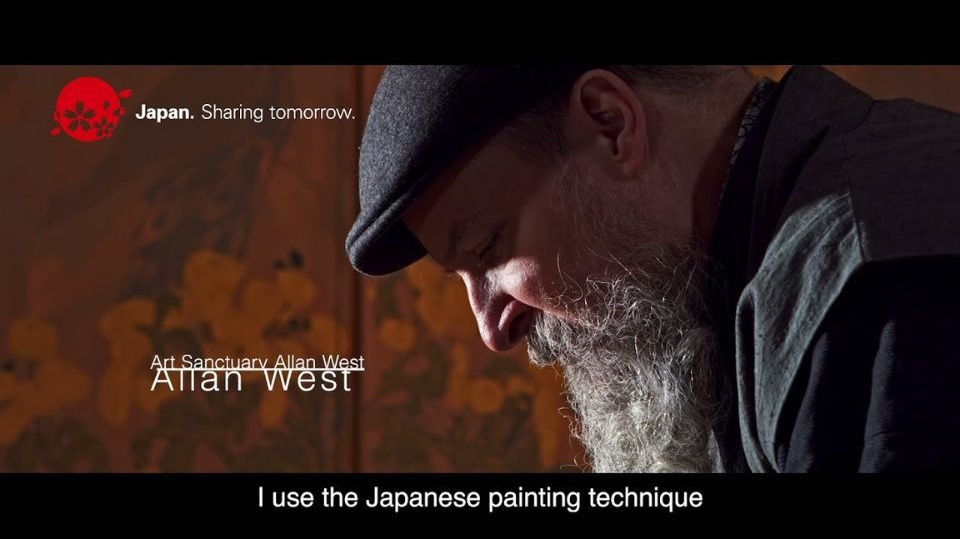Expressing the beauty and essence of the natural seasons, an American artist turned his back on the Western style of painting to learn about traditional Japanese painting techniques and materials.

Allan West paints on the flat surface of tatami mats to stop the thinner natural mineral pigments from running.
“I was shocked to learn that what I thought was my own technique of using animal glue has in fact been used in Japan for a very long time,” says Allan West. From an early age, West loved to capture scenes of nature, and aspired to be a painter. However, he found it difficult to portray the delicate lines of plants and flowers using oils, so he sought to make his own pigments and canvases from rabbit-protein glue and marble. After graduating from high school, West entered Carnegie Mellon University, one of the leading art colleges in the United States. There, he turned his back on the traditional thick brushstrokes of oil painting mainly taught in American colleges, instead showing his individualistic spirit by experimenting with other materials in his depiction of nature.

Pigments are made from natural minerals such as lapis lazuli and malachite. Additionally, glue, which is hardened into a stick for longer storage, and gold leaf are used.
One day, seeing West’s artwork at an exhibition, a woman happened to mention that similar techniques could be found in Japanese painting. Wanting to find out more about those methods, West took a hiatus from his studies and headed to Japan, a country he knew nothing about. There, he was impressed with his introduction to nihonga (traditional Japanese painting). He found the deer-protein glue used in nihonga to be far less odorous and cloudy than the rabbit glue he had previously used. West was also impressed with the countless colors of the natural mineral pigments made from powdered rock, as well as with the brushes that allow for more open and expressive lines. Pleasant to work with, these organic materials capture the beauty of nature and leave a lasting clear vibrancy for more than a thousand years. After graduating from university in the United States, West returned to Japan and entered the Graduate School of Japanese Painting at Tokyo University of the Arts. It was there, under the tutelage of KAYAMA Matazo, that he learned the techniques of nihonga in depth.

Inside the Allan West studio-cum-gallery, the traditional latticed ceiling of which West has adorned with dragons, plants, and flowers.

West opened his studio gallery after renovating an auto body garage in the downtown area of Yanaka, full of Buddhist temples and old houses.
Not far from Tokyo University of the Arts is Yanaka, a temple neighborhood of Tokyo from the Edo period (1603-1867) with many old Japanese buildings still standing. West was fascinated by that part of Tokyo, packed full of well-known stores specializing in nihonga materials. This fascination led him to renovate an old auto body garage so that he could open his own Japanese-style studio-cum-gallery in the neighborhood. Stepping inside, the visitor is transported into a magical world full of art painted with gold, silver, and copper leaf, as well as containers filled with finely powdered natural mineral pigments. It’s not unusual for neighbors to stop by for a glance of his artwork, which offers them a distinct sense of the changing seasons.
In recent years, West, along with followers of traditional performing arts such as Kabuki and Noh, has been focusing his attention on conveying the allure of Japanese culture through exhibitions and performances overseas. “Japanese culture carries with it a wisdom that cherishes the beauty of nature, a harmony with nature that is preserved in a sustainable way. It is that wisdom that I’d like to convey through my art,” remarks West softly. With such an artist capturing the beauty of nature unfettered by national boundaries in this traditional painting style, the potential of nihonga will further resonate around the world.


ALLAN WEST
Born in Washington, D.C. While a high school student, West believed he pioneered the use of animal glues mixed with natural pigments, unaware that these are the same materials used in the nihonga technique. He studied art at Carnegie Mellon University’s College of Fine Arts in the United States. West settled in Japan after several visits, entering the Graduate School of Fine Arts at Tokyo University of the Arts in 1989. A decade later, he opened Art Sanctuary Allan West, a studio-cum-gallery, in Yanaka, Tokyo. The majority of his artwork is commissioned work consisting of plant and flower paintings on hanging scrolls, folding screens, and fans. He also serves as a trustee at The Yurabi Institute for the Study and Preservation of Japan’s Cultural Heritage.































